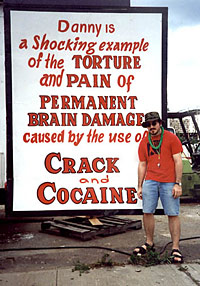 |
 |
 |
 News Around the Republic of Mexico | May 2005 News Around the Republic of Mexico | May 2005  
Crack Cocaine Sweeps Across Mexico
 Jeremy Schwartz - Cox News Jeremy Schwartz - Cox News


| | Nationwide, crack use among patients leapt from 10.5 percent to 18.7 percent at a time when consumption rates for powder cocaine and marijuana are declining. |
Merida, Yucatan - He wanted peace and quiet, an escape from the craziness of life in Mexico City and the temptations of a growing cocaine habit.

That's what led Arturo, a 46 year-old sound engineer, to bring his wife and two children to live in this ancient Mayan city, with its whitewashed buildings surrounded by the fragrant lowland jungles of the Yucatan peninsula.

But four years after his arrival in Merida, Arturo was introduced to crack.

"Someone told me, when you use crack, then you will truly know what drugs are," remembers Arturo, who asked that his last name not be revealed in this article. Soon he was selling his sound equipment and his wife's jewelry to feed his habit.

His family nearly fell apart. "I came here fleeing, looking for a solution," said Arturo, now a patient in Merida drug rehabilitation clinic. "But this drug is everywhere." For decades, the conventional wisdom has been that Mexico's drug problem is the United States. While drug cartels staged bloody battles for control of the smuggling routes to the north, Mexico's own drug consumption was among the lowest in the Western hemisphere.

But officials say Mexico is now facing its own homegrown drug epidemic, spearheaded by an alarming increase in crack use throughout the country. Some officials worry that Mexico may be headed for the type of violence the introduction of crack visited upon U.S. cities in the 1980s.

"It puts us in the worst of two worlds," said Jorge Chabat, a Mexico City political analyst and expert on drug trafficking. "We're still a transit and producing country, but now we are a consumer country as well." Mexico is largely unprepared to deal with this new domestic drug problem, officials and analysts said.

The country's legal and law enforcement systems, accustomed to combating the large-scale drug wars against the drug trafficking cartels, are unwieldy. Local agencies are constitutionally prohibited from investigating drug crimes and Mexico's drug possession laws don't adequately address domestic distribution.

The rapid spread of domestic drug use is requiring new ways of thinking: Mexicans have coined a word to describe the phenomenon, "narcomenudeo," or retail drug dealing, to differentiate it from traditional narcotrafficking. Lawmakers are studying wholesale changes to the nation's drug laws.

Schools in large cities have begun inspecting backpacks as youth drug consumption numbers soar. Newspapers have begun reporting on a new trend: homes used by addicts to buy drugs and get high the traditional crack house.

Federal prosecutors say domestic drug deals have nearly tripled in Mexico in the last four years, from 929 cases in 2001 to 2,500 in 2004.

In Mexico City, law enforcement officials saying there now exist 2,111 illegal drug distribution points, compared to 700 in 2000. In March, officials assembled the first domestic drug task forces in this city of 20 million.

Joel Ortega, Mexico City's police chief, says a ton-and-a-half of cocaine and crack are consumed per month in Mexico's capital and warns of border-like violence in the cities.

"The small gangs are imitating the way that drug cartels operate in other places, and we have to view this with sufficient caution because they are competing for territory with ferocity," Ortega recently told reporters.

For reasons not entirely clear to police, the city of Merida, on the other side of the Yucatan peninsula from Cancun, has one of the highest rates of crack use in Mexico, according to a study by the government-run Center for Juvenile Integration. Between 2001 and 2003, the percentage of drug treatment patients in Merida who used crack jumped from 4 percent to just over 36 percent.

Nationwide, crack use among patients leapt from 10.5 percent to 18.7 percent at a time when consumption rates for powder cocaine and marijuana are declining. Officials say the jump was largely attributable to increases in the far-flung locales like the Yucatan peninsula and Chiapas.

The increase in crack use among rehab patients is alarming because it is often an indicator of trends likely to hit the larger population, analysts said. In recent years, crack has almost completely displaced powder cocaine on Merida's streets, former users say.

"Many people come here because the levels of violence are low," said Victor Ramón Roa Muñoz, director of the Merida chapter of Center for Juvenile Integration. "But we run the risk that drugs and crack in particular will increase that violence." Experts say the increased presence of drugs in Mexico began with the downfall of the large Colombian cartels in the 1980s and '90s. The newer cartels began paying for the transportation of their drugs, largely cocaine, with drugs instead of money. "That made it necessary to transfer the cocaine into money locally," said Ricardo Gluyas Millán, an investigator at Mexico City's National Institute of Penal Sciences.

President Vicente Fox's government has also claimed some responsibility for the glut of drugs available domestically in Mexico, saying that increased effectiveness in battling the cartels has prevented the large groups from getting all their cargo across the border and into the United States.

With more drugs available in Mexico, he told foreign reporters in March, there has been more domestic drug use.

But while increased availability and low prices have helped fuel this rise, observers say a changing society is also a factor.

In Merida, Roa points to a complex stew: the city's proximity to Cancun and the influence of foreign tourists; high levels of immigration to the United States and residents who bring back drug habits; and high unemployment levels leading to feelings of desperation. | 
 | |
 |



